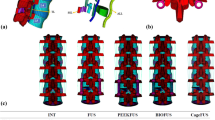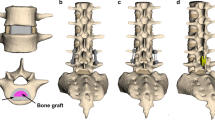Abstract
In this study finite element model of the human lumbar spinal segments (L2–L5) was developed to parametrically examine the stiffness of a dynamic stabilization device and its influence on the mobility of adjacent intervertebral segments. Five models were analyzed and compared: (1) a lumbar spine with intact discs, a reference; (2) a fused spine with a fixation device following interbody fusion and total laminectomy; (3) a spine stabilized with a dynamic stabilization device following total laminectomy; and (4) an additional vertically parallel paired dynamic posterior fixator and paired rigid fixator implemented at levels L3–L5. The disc pressure on the adjacent segments in the fused spine was greater than that of the intact spine, but the disc pressure of the dynamically stabilized spine was similar to that of the intact spine. The use of dynamic stabilization devices restored functionality more closely to that of the intact spine compared to the fused spine. The stiffness values utilized in the device were determined to be important design parameters for manufacturing dynamic stabilization devices.
Similar content being viewed by others
References
Bono, C. M. and Lee, C. K., “Critical Analysis of Trends in Fusion for Degenerative Disc Disease Over the Past 20 Years: Influence of Technique on Fusion Rate and Clinical Outcome,” Spine, Vol. 29, No. 4, pp. 455–463, 2004.
Cripton, P. A., Jain, G. M., Wittenberg, R. H., and Nolte, L.-P., “Load-Sharing Characteristics of Stabilized Lumbar Spine Segments,” Spine, Vol. 25, No. 2, pp. 170–179, 2000.
Chen, C. S., Chen, W. J., Cheng, C. K., Jao, S. H. E., Chueh, S. C., and Wang, C. C., “Failure Analysis of Broken Pedicle Screws on Spinal Instrumentation,” Medical Engineering & Physics, Vol. 27, No. 6, pp. 487–496, 2005.
Chow, D. H., Luk, K. D., Evans, J. H., and Leong, J. C., “Effects of Short Anterior Lumbar Interbody Fusion on Biomechanics of Neighboring Unfused Segments,” Spine, Vol. 21, No. 5, pp. 549–555, 1996.
Stoll, T. M., Dubois, G., and Schwarzenbach, O., “The Dynamic Neutralization System for the Spine: A Multi-Center Study of a Novel Non-Fusion System,” European Spine Journal, Vol. 11, No. 2, pp. S170–S178, 2002.
Vaga, S., Brayda-Bruno, M., Perona, F., Fornari, M., Raimondi, M., et al., “Molecular MR Imaging for the Evaluation of the Effect of Dynamic Stabilization on Lumbar Intervertebral Discs,” European Spine Journal, Vol. 18, No. 1, pp. 40–48, 2009.
Schaeren, S., Broger, I., and Jeanneret, B., “Minimum Four-Year follow-up of Spinal Stenosis with Degenerative Spondylolisthesis Treated with Decompression and Dynamic Stabilization,” Spine, Vol. 33, No. 18, pp. 636–642, 2008.
Cunningham, B. W., Sefter, J. C., Shono, Y., and McAfee, P. C., “Static and Cyclical Biomechanical Analysis of Pedicle Screw Spinal Constructs,” Spine, Vol. 18, No. 12, pp. 1677–1688, 1993.
Kim, K., Park, W. M., Kim, Y. H., and Lee, S., “Stress Analysis in a Pedicle Screw Fixation System with Flexible Rods in the Lumbar Spine,” Proceedings of the Institution of Mechanical Engineers, Part H: Journal of Engineering in Medicine, Vol. 224, No. 3, pp. 477–485, 2010.
Lu, Y. M., Hutton, W. C., and Gharpuray, V. M., “Do Bending, Twisting, and Diurnal Fluid Changes in the Disc Affect the Propensity to Prolapse? A Viscoelastic Finite Element Model,” Spine, Vol. 21, No. 22, pp. 2570–2579, 1996.
Goel, V. K., Kim, Y. E., Lim, T., and Weinstein, J. N., “An Analytical Investigation of the Mechanics of Spinal Instrumentation,” Spine, Vol. 13, No. 9, pp. 1003–1011, 1988.
Shirazi-Adl, A., Ahmed, A. M., and Shrivastava, S. C., “Mechanical Response of a Lumbar Motion Segment in Axial Torque Alone and Combined with Compression,” Spine, Vol. 11, No. 9, pp. 914–927, 1986.
Guan, Y., Yoganandan, N., Zhang, J., Pintar, F. A., Cusick, J. F., et al., “Validation of a Clinical Finite Element Model of the Human Lumbosacral Spine,” Medical and Biological Engineering and Computing, Vol. 44, No. 8, pp. 633–641, 2006.
Pintar, F. A., Yoganandan, N., Myers, T., Elhagediab, A., and Sances Jr, A., “Biomechanical Properties of Human Lumbar Spine Ligaments,” Journal of Biomechanics, Vol. 25, No. 11, pp. 1351–1356, 1992.
Polikeit, A., Ferguson, S. J., Nolte, L. P., and Orr, T. E., “Factors Influencing Stresses in the Lumbar Spine after the Insertion of Intervertebral Cages: Finite Element Analysis,” European Spine Journal, Vol. 12, No. 4, pp. 413–420, 2003.
Schmidt, H., Galbusera, F., Rohlmann, A., Zander, T., and Wilke, H.-J., “Effect of Multilevel Lumbar Disc Arthroplasty on Spine Kinematics and Facet Joint Loads in Flexion and Extension: A Finite Element Analysis,” European Spine Journal, Vol. 21, No. 5, pp. 663–674, 2012.
Vadapalli, S., Sairyo, K., Goel, V. K., Robon, M., Biyani, A., et al., “Biomechanical Rationale for using Polyetheretherketone (PEEK) Spacers for Lumbar Interbody Fusion–a Finite Element Study,” Spine, Vol. 31, No. 26, pp. E992–E998, 2006.
Ahn, Y. H., Chen, W. M., Lee, K. Y., Park, K. W., and Lee, S. J., “Comparison of the Load-Sharing Characteristics between Pediclebased Dynamic and Rigid Rod Devices,” Biomedical Materials, Vol. 3, No. 4, Paper No. 044101, 2008.
Kim, Y., “Finite Element Analysis of Anterior Lumbar Interbody Fusion: Threaded Cylindrical Cage and Pedicle Screw Fixation,” Spine, Vol. 32, No. 23, pp. 2558–2568, 2007.
Hartmann, F., Janssen, C., Böhm, S., Hely, H., Rommens, P. M., and Gercek, E., “Biomechanical Effect of Graded Minimal-Invasive Decompression Procedures on Lumbar Spinal Stability,” Archives of Orthopaedic And Trauma Surgery, Vol. 132, No. 9, pp. 1233–1239, 2012.
Schilling, C., Krüger, S., Grupp, T., Duda, G., Blömer, W., and Rohlmann, A., “The Effect of Design Parameters of Dynamic Pedicle Screw Systems on Kinematics and Load Bearing: An in Vitro Study,” European Spine Journal, Vol. 20, No. 2, pp. 297–307, 2011.
Liu, C. L., Zhong, Z. C., Hsu, H. W., Shih, S. L., Wang, S. T., et al., “Effect of the Cord Pretension of the Dynesys Dynamic Stabilisation System on the Biomechanics of the Lumbar Spine: A Finite Element Analysis,” European Spine Journal, Vol. 20, No. 11, pp. 1850–1858, 2011.
Patwardhan, A. G., Havey, R. M., Meade, K. P., Lee, B., and Dunlap, B., “A Follower Load Increases the LoadCarrying Capacity of the Lumbar Spine in Compression,” Spine, Vol. 24, No. 10, pp. 1003–1009, 1999.
Renner, S. M., Natarajan, R. N., Patwardhan, A. G., Havey, R. M., Voronov, L. I., et al., “Novel Model to Analyze the Effect of a Large Compressive Follower Pre-Load on Range of Motions in a Lumbar Spine,” Journal of Biomechanics, Vol. 40, No. 6, pp. 1326–1332, 2007.
Viscogliosi, A. G., Viscogliosi, J. J., and Viscogliosi, M. R., “Beyond Total Disc: The Future of Spine Surgery,” Viscogliosi Bros., LLC, 2004.
Sengupta, D. K., “Dynamic Stabilization Devices in the Treatment of Low Back Pain,” Orthopedic Clinics of North America, Vol. 35, No. 1, pp. 43–56, 2004.
Dahl, B., Gehrchen, P., Blyme, P., Kiaer, T., and Tøndevold, E., “Clinical Outcome after Spinal Fusion with a Rigid Versus a Semi- Rigid Pedicle Screw System,” European Spine Journal, Vol. 6, No. 6, pp. 412–416, 1997.
Bono, C. M., Khandha, A., Vadapalli, S., Holekamp, S., Goel, V. K., and Garfin, S. R., “Residual Sagittal Motion after Lumbar Fusion: A Finite Element Analysis with Implications on Radiographic Flexion-Extension Criteria,” Spine, Vol. 32, No. 4, pp. 417–422, 2007.
Ianuzzi, A., Kurtz, S. M., Kane, W., Shah, P., Siskey, R., et al., “In Vivo Deformation, Surface Damage, and Biostability of Retrieved Dynesys Systems,” Spine, Vol. 35, No. 23, pp. E1310–E1316, 2010.
Wilke, H. J., Heuer, F., and Schmidt, H., “Prospective Design Delineation and Subsequent in Vitro Evaluation of a New Posterior Dynamic Stabilization System,” Spine, Vol. 34, No. 3, pp. 255–261, 2009.
Author information
Authors and Affiliations
Corresponding author
Additional information
Kyoung-Tak Kang and Ho-Joong Kim contributed equally to this work.
Rights and permissions
About this article
Cite this article
Kang, KT., Kim, HJ., Son, J. et al. Comparing an instrumented posterior fixation system with rigid and semi-flexible rods using finite element analysis. Int. J. Precis. Eng. Manuf. 16, 163–170 (2015). https://doi.org/10.1007/s12541-015-0021-5
Received:
Revised:
Accepted:
Published:
Issue Date:
DOI: https://doi.org/10.1007/s12541-015-0021-5




